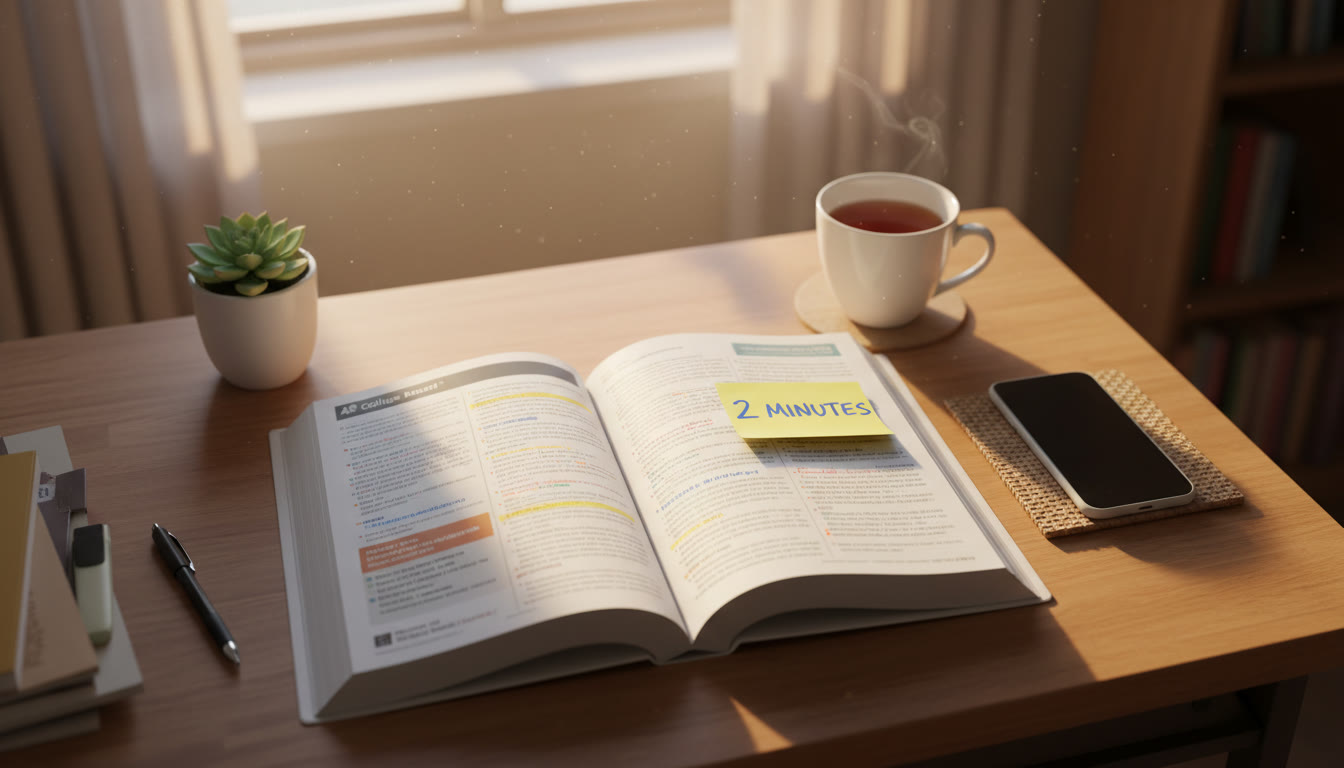Why This Guide Exists (And Why Two Minutes Can Save Your AP Semester)
If you’re reading this between scrolling through Instagram, doomscrolling about college apps, or staring at your textbook like it’s a foreign language, welcome. This blog is for the brilliant, busy, and perfectly human group of students who say they’ll start — and then don’t. You’re not alone. AP classes pile on rigor while life keeps throwing curveballs: sports, jobs, family responsibilities, and the magnetic pull of the couch.
Procrastination isn’t a personality deficiency; often it’s a reaction to overwhelm. The antidote isn’t brutal discipline but tiny, predictable beginnings. The Two-Minute Start (a concept borrowed and adapted for AP success) converts ‘I’ll start tomorrow’ into ‘I’ll do two minutes now’ — and those two minutes are the most powerful small habit you can build for AP mastery.

What a Two-Minute Start Actually Is
Two minutes is deliberately tiny. It’s not ‘review for two minutes’ in a vague way; it’s a concrete, atomic action that requires almost zero emotional energy. Examples:
- Open the AP Biology textbook and read the first two sentences of a section.
- Write one concise thesis sentence for an AP English free-response prompt.
- Do three multiple-choice questions from an AP Calculus practice set and mark which rules helped you.
Why it works: small wins reduce resistance. Two minutes helps you cross the initiation hurdle so you can either stop (still better than zero) or keep going. Often, once those two minutes are done, momentum carries you 10–30 minutes further. When it doesn’t, two minutes still gives you the psychological win you need for tomorrow.
How to Design Your Two-Minute AP Sessions
Designing micro-sessions requires specificity. An effective two-minute task should have:
- A clear beginning (e.g., “Open AP US History Chapter 8”).
- A clear, measurable tiny action (e.g., “Write 1 sentence summarizing the chapter’s main idea”).
- An optional follow-up step (e.g., “If I feel okay, do one practice question”).
Here are templates for different AP subjects:
- AP Science: “Skim the conclusion paragraph of one experiment and underline one variable relationship.”
- AP Math: “Write down the formula you’re rusty on and solve one short example.”
- AP English: “Read a model thesis and underline its technique; write one sentence emulating it.”
- AP History: “Read two primary-source lines and note the author’s perspective in one word.”
Micro-Tools You Should Keep Handy
To make two minutes count, collect quick tools:
- A pocket notebook or notes app for one-sentence summaries.
- A 10-question practice packet saved as a PDF for fast access.
- A timer (your phone’s timer or a physical kitchen timer).
Build a Tiny Routine: When Two Minutes Becomes Habit
Habit formation is about context and repetition. Place two-minute starts in predictable moments: right after lunch, first thing after school, or before bed. The repetition creates a neural pathway that reduces friction over time.
Sample weekly plan for a procrastinator who’s juggling three APs (English, Biology, and Calculus):
| Time Slot | Two-Minute Task | Optional Follow-Up |
|---|---|---|
| After School (3:30 pm) | Read 2 sentences from Biology chapter summary | Do 1 quick multiple-choice question |
| Pre-Dinner (6:00 pm) | Write one thesis sentence for an English prompt | Outline a 5-sentence paragraph |
| Before Bed (9:30 pm) | Solve one Calculus limit or derivative step | Check an error or look up a rule |
Notice the plan doesn’t aim for hours. It’s realistic and repeatable — the secret sauce for procrastinators.
Two-Minute Starts for Different AP Exam Types
AP exams vary: multiple choice, short answers, document-based essays, lab-based questions, and open-ended problems. Tailor your two-minute tasks to the exam format.
For Multiple-Choice Heavy Exams (AP Physics, AP Psychology, AP Microeconomics)
- Two-Minute Task: Do two representative multiple-choice questions and mark which distractor tricked you.
- Why it helps: You build pattern recognition and quickly identify common traps.
For Free-Response/Evidence-Based Exams (AP English, AP History, AP Environmental Science)
- Two-Minute Task: Draft the main claim and three bits of evidence (one sentence each).
- Why it helps: It trains you to organize evidence fast — a huge advantage when time is tight on test day.
For Problem-Solving Exams (AP Calculus, AP Chemistry, AP Computer Science A)
- Two-Minute Task: Jot down a formula or algorithm and do one quick check problem.
- Why it helps: Keeping procedural knowledge fresh prevents costly slowdowns during multi-step problems.
How to Turn Two Minutes into Focused Study Sprints
Two minutes often expand naturally. Use this nudge to launch a 20–30 minute sprint when possible. Here’s how to make that leap reliably:
- Set a micro-reward: a favorite song after a 25-minute sprint, a square of chocolate, or 10 minutes of scroll time.
- Use the two-minute task as a bridge: if you finish that tiny step and you feel okay, commit to ‘just one Pomodoro’ (25 minutes) — it’s easier to agree to one Pomodoro than a vague long study session.
- Pair the start with environmental cues: open a certain playlist, plug in headphones, use a study lamp, or clear your desk for five seconds.
Tracking Progress Without Overwhelm
Tracking shouldn’t become another task you procrastinate on. Keep it minimal. A simple habit tracker with checkboxes is enough:
| Day | AP Subject | Two-Minute Check | Optional Sprint |
|---|---|---|---|
| Mon | Biology | ✔ | 25 min |
| Tue | English | ✔ | |
| Wed | Calculus | ✔ | 25 min |
Celebrate streaks of 3–5 two-minute wins in a row. Momentum compounds. If a streak breaks, reset compassionately; you’re building a system, not perfect behavior.
Study Strategies That Pair Perfectly With Two-Minute Starts
Two-minute starts are a scaffold for proven learning techniques. Use them to access and deploy these strategies:
Active Recall
Two minutes is ideal for forcing retrieval: ask yourself a question and answer it in a sentence. For example, instead of rereading a chapter, close the book and write one sentence explaining the concept.
Spaced Repetition
Micro-sessions let you revisit material every day without heavy planning. Put weak concepts on a short rotation (daily two-minute check-ins) and stronger material on a longer cadence.
Interleaved Practice
Don’t study one topic exclusively. A two-minute rotation can cycle subjects across a study block: two minutes of calculus, two minutes of biology, two minutes of vocabulary. This improves adaptability on test day.
AP Exam Logistics & Smart Administrative Moves
Procrastination isn’t only about study content; it’s also about forgetting administrative details. Use two-minute checks to avoid costly oversights.
- Confirm exam registration deadlines and test dates early in the year; put them in your calendar.
- Use a two-minute session to verify your testing location and what materials (calculator, ID) are allowed on test day.
- Set a reminder to use your free score send before the College Board deadline each year (this avoids future fees and stress).
When You Need More Than Two Minutes: Where Sparkl Helps
Two-minute starts build habit and momentum, but some learning gaps need personalized diagnosis and practice. That’s where targeted tutoring is useful. Sparkl’s personalized tutoring offers 1-on-1 guidance, tailored study plans, expert tutors who know AP rubrics, and AI-driven insights that help identify weak spots quickly. If you hit a plateau — especially in writing intensive APs or problem-heavy subjects — a few focused sessions with an expert can translate your micro-starts into consistent, strategic progress.
Use Sparkl for:
- Tailored study plans that convert two-minute tasks into meaningful practice cycles.
- Expert feedback on written responses and labs to increase score-earning techniques.
- Short, focused tutoring sessions focused on exactly the topics your two-minute checks reveal as trouble spots.
Real Student Scenarios: Turning Two Minutes into Exam Wins
These are short, realistic case studies of how two-minute starts help different students.
Case 1: Sam — The Late-Night Crammer
Sam used to stay up late bingeing notes and then cramming the night before an AP exam. He adopted a two-minute early-evening ritual: reading the first paragraph of the next day’s chapter and summarizing it in one line. After two weeks, the chapters lost their intimidation, Sam began doing optional 25-minute sprints, and his anxiety dropped — he started recalling concepts more reliably during timed practice tests.
Case 2: Aisha — The Overloaded Athlete
Aisha balanced varsity practice with AP classes and felt small study windows were all she had. She used two-minute starts in the locker room: jotting one formula or one quick evidence line on a sticky note. When she had down-time on buses or between practice drills, she reviewed those notes for a minute or two. By game week, her recall was sharp and she avoided all-night sessions before exams.
Case 3: Mateo — The Essay-Focused Student
Mateo struggled with AP History essays. His two-minute habit was to read one model thesis and write one sentence in that style. Within a month, his outline speed improved — what used to take 20 minutes became 7 — and his essays became more focused. He later used some sessions with a Sparkl tutor to refine evidence selection and rubrics, which boosted his score confidence further.
Practical Checklists: Two-Minute Start Pack
Keep this printable checklist (or copy it into a notes app) for immediate use:
- Choose 2–3 AP subjects to rotate each day.
- For each subject, write one two-minute task template (e.g., “Write one thesis”, “Solve one limit”).
- Decide two daily anchors: times you’ll always do a two-minute start (e.g., after lunch, before bed).
- Track wins with a checkbox — celebrate five in a row.
- If stuck for >3 days, book a short diagnostic session with an expert (Sparkl’s short-guided help can pinpoint quick wins).
Common Roadblocks and How to Beat Them
Even the best-laid two-minute plans encounter friction. Here are real problems and practical fixes:
- Roadblock: “I forget.” Fix: Pair the task with an existing habit (brush teeth, eat lunch) and set phone reminders.
- Roadblock: “Two minutes never leads to more.” Fix: Add a low-cost commitment like “If I do two minutes, I will play one song as a reward; if I continue, I’ll get a 25-minute reward.”
- Roadblock: “I do it but don’t improve.” Fix: Use two-minute sessions for diagnostic tasks (identify the one concept you don’t understand) rather than passive reading; consider a short tutoring check-in to target persistent gaps.
How to Use Two-Minute Starts in the Final Countdown Before an AP Exam
As the exam approaches, scale your two-minute tasks to strategic moves:
- One week out: use two-minute checks for quick formula, vocabulary, or evidence recall. Prioritize mistakes on practice tests.
- Three days out: do two-minute timed prompts: write one thesis, solve one multi-step problem, or analyze one primary source under a short time pressure.
- The night before: a calming two-minute review — skim a favorite summary, pack your bag, and do a breathing exercise. Avoid last-minute cramming that sabotages sleep.
Final Thoughts: Small Starts, Big Results
AP success rarely comes from a single all-night push. It’s built from small, steady actions that move the needle day after day. If you’re a procrastinator, change the shape of your start — make it tiny, kind, and immediate. Two minutes is a permission slip to begin. It’s not magic, but it’s the practical trick that dissolves resistance and leads to meaningful, cumulative gains.
And when small starts reveal stubborn gaps, don’t hesitate to get targeted help. Personalized guidance — like short, focused sessions with Sparkl’s tutors — can convert your two-minute wins into confident exam performance. Start tiny, stay consistent, and watch your AP momentum grow. You’ve got this.

Quick Resources to Save in Your AP Toolkit
- One-line summaries for each unit (keep them in a single notes file).
- A 20-question mixed practice PDF for rapid daily checks.
- A short list of exam logistics and the free score-send deadline to avoid last-minute fees.
- Contact info for a trusted tutor or service for quick, targeted help when two-minute starts reveal deeper needs.
Parting Encouragement
Procrastination isn’t a character flaw; it’s a solvable habit. Two-minute starts honor your current bandwidth and give you a way forward that’s compassionate, practical, and surprisingly effective. Use them consistently, layer in powerful study strategies, and reach out for brief personalized help when you need it. AP season doesn’t have to feel like a marathon — let it feel like a sequence of doable, human-sized steps.
Ready? Take two minutes right now: open the nearest AP book and read two sentences. That’s it. Then close this tab and savor that tiny win.






















No Comments
Leave a comment Cancel